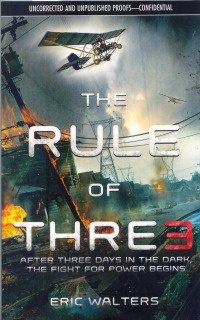| ________________
CM . . .
. Volume XX Number 20. . . .January 24, 2014
excerpt:
Life as Adam Daley knows it ends when everything computerized shuts down. Adam is an intelligent, authentic male teen protagonist. He is also lucky; not only does he drive an old car that runs without computers, but he and his airline pilot father are building an ultralight airplane in their garage and his soon-to-be-girlfriend lives on a farm with horses for transport, a well for water, and land on which to grow crops. His mother is the officer in charge at the local police station and so has general authority in the town and, to top it all off, Herb, his elderly neighbour is an ex-government operative – but that's all classified. When the world changes, Adam's first thoughts are of his father who is out of town on a flight and unable to return home, but Adam snaps into action, picks up his younger twin siblings and drives his friends home where he awaits his mother and a report on what exactly happened. But there is no explanation. No one knows exactly what happened or why, and there is no way to find out. Adam's neighbour Herb takes over as Adam’s father figure as they begin to prepare for a long-term disaster, negotiate civilized living in their neighbourhood, and philosophize about society's reactions to catastrophe. It is revealed that Herb has experience with this kind of disaster situation and is prepared with stores of food, water, chemicals, generators, and everything else useful in a loss of technology situation. He is the one who cites the Rule of Three to Adam: "You can go without air for three minutes, without water for three days, and without food for three weeks. Beyond that, you're dead." The story sees Herb and Adam tackle major themes like hope, civility, humanity, greed, and survival. Using his experience, wisdom and stores of resources, Herb quickly becomes a leader in the community. As the rule of three is lived out, three days and people start running out of water and three weeks for people to run out of food, civilization quickly dissolves as looting for resources, which results in violence, occurs. This can make this first installment feel really long. Walters tries to keep to a realistic timeline, but the three weeks takes an agonizingly long time to pass as society slowly crumbles, and following this there are still more decisions to be made, plans to be executed, and then, as Herb has seemingly unlimited foresight and resources, for any action and survival to really begin. It isn't until about halfway through the book that Adam takes to the air in and the action begins. Herb works with the police to predict the next situation and try to maintain peace. Adam's mom in this relationship often comes across as indecisive and, as decisions do have to be made, her authority is repeatedly subverted and manipulated by Herb. When Herb proposes that, in order to survive, their most viable course of action is to take only the people with important skills sets and settle on a farm, Adam refuses to leave the rest of his neighbours behind. In a decision that showcases his intelligence, optimism and pragmatism Adam proposes creating the 'Neighbourhood', a fortified, self-sufficient town, in order to survive and keep all 1600 citizens of the Neighbourhood alive as well: lawns are turned into farmland, parks are turned into pastures and garages are turned into green houses. As a closed community, the Neighbourhood can fend off enemies and trade with neighbouring communities. That is, until a militant community begins to wreck havoc and Adam and Herb have to devise a plan involving Adam's airplane, teamwork and a lot of danger. The Rule of Three is an interesting read which maintains a realistic premise as it sets up this first book in a planned trilogy. While it doesn't yet explain the global loss of technology, it does teach useful survival tips and tricks through Herb who also emphasizes the importance of civility, diplomacy, planning and making difficult decisions in desperate times. It would have been nice for the female figures in the novel to step up. Adam's mom looks to Herb for all the answers, and Adam's girlfriend Lori is absent except for Adam’s off time when he has time for romance. The twins, Adam’s siblings, are, for the most part, kept in the dark and are simply not present in the latter half of the book. It will be interesting to see how the sequels deal with growing up in this changed environment. However, it is Adam's ethical qualms about the ruthless decisions that Herb insists they must make - turning people away from their sanctuary, treating unknown people as threats, premeditated attacks – that make for nuanced reading. The book doesn't delve too deeply into these discussions, leaving a lot of moral ambiguity and opening up areas for discussion. I would recommend The Rule of Three to those who enjoy realism, stories of survival and also to those who like post apocalyptic science fiction. Adam is a likeable, intelligent character who would especially appeal to boys. The book offers wonderful discussions of airplanes and flight, survival, and the importance of community, questions of humanity and human endurance. Recommended. Stephanie Dror is in the MA in Children's literature program at the School of Library and Archival Studies, the University of British Columbia.
To comment
on this title or this review, send mail to cm@umanitoba.ca.
Copyright © the Manitoba Library Association. Reproduction for personal
use is permitted only if this copyright notice is maintained. Any
other reproduction is prohibited without permission.
NEXT REVIEW |
TABLE OF CONTENTS FOR THIS ISSUE
- January 24, 2014.
AUTHORS |
TITLES |
MEDIA REVIEWS |
PROFILES |
BACK ISSUES |
SEARCH |
CMARCHIVE |
HOME |
